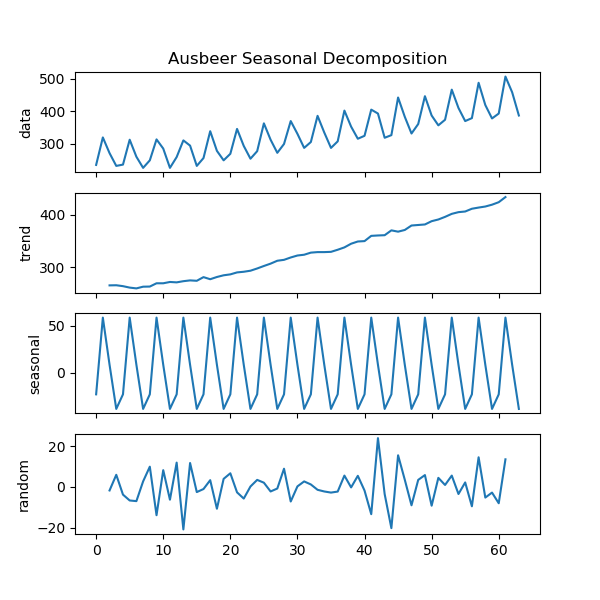Seasonal decomposition of your time-series¶
This example demonstrates how we can use the decompose function to extract
the trend, seasonal, and random components of the time series and then
plot them all using the decomposed_plot function. We’ll be plotting both
additive and multiplicative examples of seasonality. To see the R
equivalent that inspired this example go here.
print(__doc__)
# Author: Charles Drotar <drotarcharles@gmail.com>
from pmdarima import arima
from pmdarima import datasets
from pmdarima import utils
# #############################################################################
# So what is happening when we call `decomposed`?
# 1) The trend is extracted from the signal via a convolution using either a
# SMA or a user-defined filter.
# 2) We remove the effects of the trend from the original signal by either
# subtracting its effects or dividing out its effects for `additive` or
# 'multiplicative' types of decompositions, respectively. We then take the
# mean across all seasons to get the values for a single season. For m=4, we
# expect 4 values for a single season.
# 3) We then create the seasonal series by replicating the single season
# until it is the same length of the trend signal.
# 4) Lastly to get the random/noise elements of the signal we remove the effects
# of both the trend and seasonal series and we are now left with the
# variation of the original signal that is neither explainable by seasonal
# nor trend effects.
#
# This logic produces a named tuple of the original signal, trend, seasonal,
# and random components. It is this named tuple that is passed to
# `decomposed_plot`
figure_kwargs = {'figsize': (6, 6)} # set figure size for both examples
#
# ADDITIVE EXAMPLE : ausbeer
#
# Decompose the ausbeer dataset into trend, seasonal and random parts.
# We subset to a small window of the time series.
head_index = 17*4+2
tail_index = 17*4-4
first_index = head_index - tail_index
last_index = head_index
ausbeer = datasets.load_ausbeer()
timeserie_beer = ausbeer[first_index:last_index]
decomposed = arima.decompose(timeserie_beer, 'additive', m=4)
# Plot the decomposed signal of ausbeer as a subplot
axes = utils.decomposed_plot(decomposed, figure_kwargs=figure_kwargs,
show=False)
axes[0].set_title("Ausbeer Seasonal Decomposition")
#
# MULTIPLICATIVE EXAMPLE: airpassengers
#
# Decompose the airpassengers dataset into trend, seasonal and random parts.
decomposed = arima.decompose(datasets.load_airpassengers(),
'multiplicative', m=12)
# Plot the decomposed signal of airpassengers as a subplot
axes = utils.decomposed_plot(decomposed, figure_kwargs=figure_kwargs,
show=False)
axes[0].set_title("Airpassengers Seasonal Decomposition")
Total running time of the script: ( 0 minutes 0.058 seconds)

